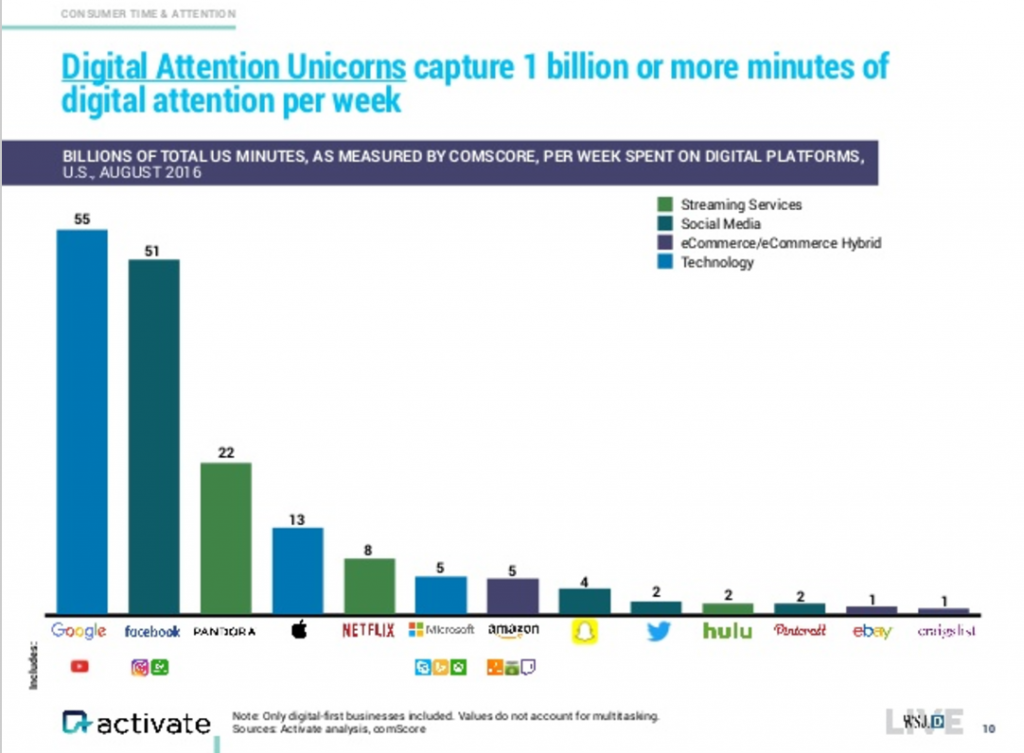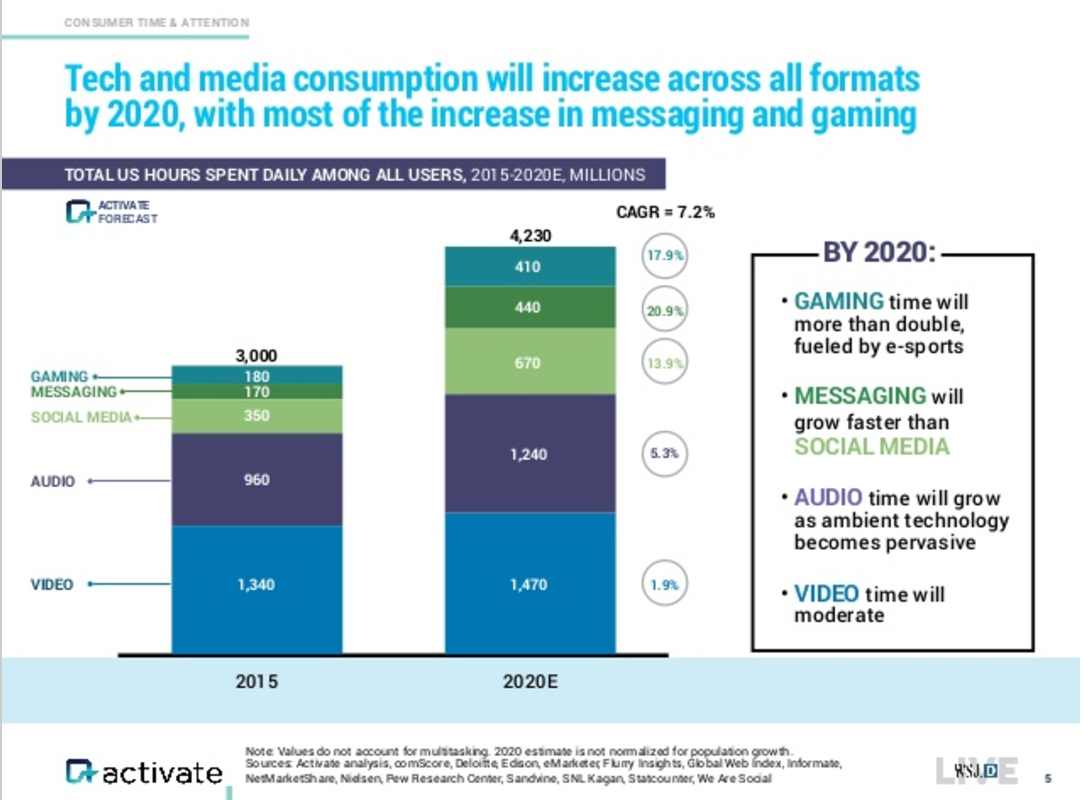The Biggest Companies in the World are All Fighting for One Thing

On November 19, 2006, Nintendo released one of its many video game consoles to the world, but this one with special attention. The Wii was one of the very first consoles to track actual movement in three dimensions, an incredible achievement that likely led to the Wii’s massive consumer success. One of the games that came with the console was Wii Sports, which, despite being a relatively simple game, highlighted the technological achievement of the console by having users mimic actual athletic movements as they golfed, bowled, boxed, or played tennis.
Though it’s likely that millions of people came across the following in-game message, it’s less likely that they recognized its significance. The message read: “Why not take a break? You can pause the game by pressing +.” Accompanying the message was the image of an open window, presumably suggesting that game players might want to go outside to play actual golf or tennis for a change.
When you encountered this message, maybe you laughed at the oddity of the window illustration, or the audacity of Nintendo giving you advice about how to spend your time. Some of the more serious game players even took offense to the message. Here’s Foolish_Banana2, ranting after he or she encountered a similar Nintendo “take a break” message in Nintendo’s 2013 game Legend of Zelda: A Link Between Worlds:
Seriously, Nintendo? I get that you’re trying to promote health and safety…but did it ever occur to you that giving us messages like this could actually hurt your company? You’re a gaming company. If you want people to stop playing your games, then why even bother making games to begin with?
Therein lies the magnitude of Nintendo’s seemingly benevolent message. Why would Nintendo, a video game company, suggest that you stop playing video games to do something else? Isn’t that antithetical to the essence of Nintendo as a business? Did it ever occur to Nintendo, as Foolish_Banana2 suggests, that this “could actually hurt [the] company?”
The best analogue for Nintendo’s decision, and a damning comparison, is the packaging required by law for cigarette companies, which defies customers with the message: “Smoking kills”.
 The striking tobacco message and Nintendo’s innocuous “take a break” invitation are two ends of a spectrum with the same core message: “Our product may not be good for you.” Whereas tobacco companies are legally obligated to warn their customers, Nintendo made the advisement willingly—but why?
The striking tobacco message and Nintendo’s innocuous “take a break” invitation are two ends of a spectrum with the same core message: “Our product may not be good for you.” Whereas tobacco companies are legally obligated to warn their customers, Nintendo made the advisement willingly—but why?
They felt bad. The messages were a subtle admission of the truth that even casual video gamers intuitively understand: Video games can be bad for you. You can start playing and realize, several hours later, that you’ve neglected to do important things like eat, sleep, or interact with other people. Like any addictive behavior, obsessive video gaming can have serious consequences in your life. Nintendo knew this, and those intrusive messages, which can be found in various games over the span of years, are evidence that they knew this. Nintendo admitted that its product might have negative consequences, but hardly anyone noticed.
The Battle for Attention
You already know, of course, that video games are not the only addictive form of technology. Countless articles, especially in recent history, explore the compulsive qualities of many consumer technologies, with our favorite digital brands at the center of the conversation. But addiction is far from the lips of most people at Facebook, Google, and Twitter, who prefer a word with subtle shades of improvement: engagement. If you dig into Facebook’s annual report to investors, the first statistics you’ll see, not surprisingly, are revenue. But just below revenue? Daily active users, because engagement is the holy grail of every online platform. Or, as venture capitalist Sarah Tavel has said, “Engagement is the fuel powering most of the enduring, …non-transactional consumer companies.”
The battle for engagement is fought at the highest levels of all the major tech corporations. In December of 2016, Facebook proudly announced that it had 1.28 billion daily active users during the month, which explains precisely why Twitter can’t compete. Nearly every analysis of Twitter’s recent underperformance mentions a lack of user engagement, and it’s gotten so bad that Twitter can’t even bring itself to share how many daily active users it has. Twitter’s desperate attempts to save face have centered almost exclusively on features or functionality that would increase engagement. Can we tweak this algorithm so people stay on the page longer? If we suggest different people for users to follow, will they come back to the site sooner? From an investment perspective, Twitter looks bleak, down to $18 per share from an IPO of $41. But, as Slate writer Will Oremus has asked, “Should we hope that Twitter succeeds?” And on the flip side, are we impressed by Facebook’s engagement?
In his book World After Capital, well-known tech investor Albert Wenger argues that humanity has evolved to the point that our scarce resources are no longer food, land, or capital. Instead a new scarce resource, unique to the digital age, has emerged: attention. Wenger writes:
At the same time that our attention is limited we are using the internet to dramatically increase the amount of available content. The increase in content is well documented to be exponential, which means that most of the content that has ever been produced by humanity has been produced in the last few years…
The limited availability of attention has become the key new source of economic rents. Companies such as Google, Facebook and Twitter are valued in no small part on the amount of attention they have been able to aggregate, some of which they then resell in the form of advertising. As a result they invest heavily in algorithms designed to present ever more appealing information to their endusers in order to capture more attention.
Wenger describes attention as a scarce resource, implying that there is an economy in which we supply our attention to the highest bidders. So who are the bidders? At a 2016 Wall Street Journal tech conference, analyst Michael Wolf clearly defined them for us. He produced a slide which read, “Digital Attention Unicorns capture 1 billion or more minutes of digital attention per week.” Or in other words, these are the companies vying for billions of hours’ worth of our attention. Google and Facebook top the list, followed by Pandora, Apple, Netflix, and Microsoft. In fact, to some degree the companies line up almost in order of their actual dollar values.
 And if those billions of minutes don’t alarm us, Wolf shared another slide that should. This slide showed the total number of hours Americans spend daily on media consumption in 2015—over 3 billion hours—next to the projected number of hours by 2020: over 4.2 billion. Is it possible that the U.S. alone can increase its digital consumption by 40% in just five years?
And if those billions of minutes don’t alarm us, Wolf shared another slide that should. This slide showed the total number of hours Americans spend daily on media consumption in 2015—over 3 billion hours—next to the projected number of hours by 2020: over 4.2 billion. Is it possible that the U.S. alone can increase its digital consumption by 40% in just five years?
 Not only is it possible, but based on Wolf’s presentation it actually seems likely. If you’re a tech company, though, or you’re happily consuming for many hours on your phone, what’s the problem?
Not only is it possible, but based on Wolf’s presentation it actually seems likely. If you’re a tech company, though, or you’re happily consuming for many hours on your phone, what’s the problem?
Is It Addiction?
The answer comes back to addiction. Despite the many variations and understandings of what addiction is, let’s make two assumptions based on a definition provided by Psychology Today: 1) Addictions are compulsive, or irresistible behavior, and 2) They interfere with ordinary responsibilities or concerns. If I compulsively check Facebook on my phone, and that interferes with other responsibilities such as work I should be doing or people with whom I should be engaging, I’m addicted. By this definition, people are addicted, and the negative implications can be felt far and wide. Another venture capitalist, Paul Graham, has weighed in on the issue. A trend, you’ll notice, is that the people closest to these technology companies—the people investing in them—are wary of the negative effects on society. Graham wrote in 2010:
The world is more addictive than it was 40 years ago. And…the world will get more addictive in the next 40 years than it did in the last 40…
Most people I know have problems with Internet addiction. We’re all trying to figure out our own customs for getting free of it…[I]f I’m right about the acceleration of addictiveness, then this kind of lonely squirming to avoid it will increasingly be the fate of anyone who wants to get things done. We’ll increasingly be defined by what we say no to.
While many consumers and experts, such as Graham, can attest that tech addiction is real, the tech companies under scrutiny refuse to accept the premise of addiction. Remember, their definition is engagement. When writer Bianca Bosker wrote on this topic of technology addiction, she asked Facebook to comment. They gave her the standard line. Bosker wrote, “[Facebook] told me the social network focuses on maximizing the quality of the experience—not the time its users spend on the site—and surveys its users daily to gauge success.” Facebook, in other words, denies addiction entirely. This makes the “addiction” label all the more important.
In his recent book, Irresistible, Adam Alter offers the most comprehensive analysis of technology addiction to date. From the origins of behavioral addiction to its future implications, Alter paints the bleak state of technology addiction that is only growing worse. He writes:
There are also people who say that the term “addiction” can’t possibly apply to a majority of the population. “Doesn’t that devalue the term ‘addiction’? Doesn’t that make it meaningless and empty?” they ask. When, in 1918, a flu pandemic killed seventy-five million people, no one suggested that a flu diagnosis was completely meaningless. The issue demanded attention precisely because it affected so many people, and the same is true of behavioral addiction. Smartphones and email are hard to resist—because they’re both part of the fabric of society and promote psychologically compelling experiences—and there will be other addictive experiences in the coming decades. We shouldn’t use a watered-down term to describe them; we should acknowledge how serious they are, how much harm they’re doing to our collective well-being, and how much attention they deserve. The evidence so far is concerning, and trends suggest we’re wading deeper into dangerous waters.
What Can We Do About Tech Addiction?
If the battle for attention is only growing, as so many have suggested, and technology addiction is an epidemic, as Alter suggests, who is responsible? This question, which is difficult to answer, raises interesting parallels with another global issue: climate change. For example, we can see how the arguments about climate change, for a long time, centered around labels and terminology. Is it global warming? What about greenhouse effects? Or sustainability? In one sense, arguing about the label of a problem delays the debate about how to solve the problem. For now, awareness of technology addiction is struggling with the same debate over how it should be labeled.
And if we look at recent developments in climate change, we can identify how people have reacted to it. Some argue that the government should impose regulations on corporations to reduce their contributions to the problem. Others take the approach that the best solution is for consumers themselves to reduce their consumption of products that are not sustainable. The same debate is played out on the technology addiction stage. In effect, the goal is to find an outcome similar to that of climate change: digital sustainability. How can we have digital products that are sustainable from a psychological perspective?
Some, like writer Michael Schulson, have argued that the government should regulate tech companies whose products are addictive. “If the situation really is…exploitative,” writes Schulson, “and you aren’t naïve enough to believe that industries would regulate themselves, then you basically have one option: you regulate them.” More recently, Salesforce founder and CEO Marc Benioff shared the same view: “I think that, for sure, technology has addictive qualities that we have to address, and that product designers are working to make those products more addictive, and we need to rein that back as much as possible.” Others, like Albert Wenger, argue that the only place to start is with self-regulation: “I believe the starting point has to be self-regulation. It will be difficult to be effective in bringing about the other policy changes, including promoting democracy, if we simply add to the online yelling and real world attacks or if we stay away from participating in the knowledge loop due to fear.”
I agree with Wenger—policy is too far off and too difficult to define for us to expect any sort of blanket solution to the problem. However, I also think there is a middle ground: consumers demanding more from technology companies. Why can’t consumers, themselves, ask for more control over their newsfeeds, more visibility about the time they’re spending on a particular site, and more understanding of the triggers that pull them in? You might think, “The technology companies would never do that,” but recent events have offered a precedent suggesting that they just might.
In the months before and after the recent U.S. Presidential election, the main technology topic of conversation was “fake news.” Fake news, like technology addiction, forces technology companies to reconcile ethical dilemmas between engagement, which is good for business, and the potential for negative societal impact. By working to eliminate fake news, Facebook actually must work to reduce engagement on their platform, because fake news spreads quickly and often generates high engagement. But Facebook’s response to fake news, alongside its recent commitment to emphasize friends and family in the News Feed, demonstrates that under the right pressure from consumers and the media, they are willing to make changes at the expense of engagement.
Imagine, for example, if 100 million people installed ad-blockers, demanding that Facebook increase transparency around how it engages users by implementing a simple dashboard. Wouldn’t Facebook recognize the issue then? With enough media attention, and especially the voice of consumers, Facebook would be forced to address the addictive nature of its product and begin thinking about the ethics of how it captures our attention.
Unfortunately, the problem of internet behavioral addiction is still in the awareness stage; people are still coming to accept that the problem is real. So, the next time you tell yourself, “I’ll just check my phone real quick,” remember that the problem is more real than any of us could have expected.
